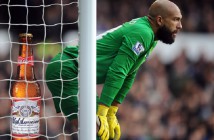Competitive sports have always been a form of popular entertainment and ritual character building. But the sporting life has always been about passion and money.
For those who grew up as Baby Boomers, the Golden Age of television wasn’t very golden for sports on TV. Especially for the athletes who were the stars.
It wasn’t until the late 1950’s that Yankee center fielder Mickey Mantle became the first baseball player to sign a contract that paid him $100,000 a year, and he was already playing through the pain of a bum knee.
Red Sox star Ted Williams, “the splendid splinter,” lost an endorsement contract because he chose to put his country ahead of his hitting skills and returned to Marine Aviation during the Korean War.
Fullback Jim Brown became the first NFL star to earn $100,000 for a season’s work. But he never won a championship while playing for coach Paul Brown in Cleveland.
There were no skyboxes. There were no multi-billion dollar TV contracts that enable leagues to share earnings and manage competition in a unique form of sports world socialism that is exempt from anti-trust laws.
What there was was 88,000 people showing up for a Browns game at Municipal Stadium before the Rust Belt was born, and over 100,000 attending the annual College All-Star Game at Chicago’s Soldier Field with the proceeds going to charity. The annual Army-Navy game played before one hundred thousand fans and sometimes even the president at Philadelphia’s Franklin Field was a bigger sports pageant than the Super Bowl for its time.
The Los Angeles Rams played close to Hollywood. But they didn’t have a Kardashian flirting and Tweeting with their stars to get publicity. Rams quarterback Bob Waterfield was married to Esther Williams and that spoke for itself.
Then something happened. Much as they gambled that America would watch a thirty minute nightly news program, CBS banked on the sporting life. Not with professional football, but with hockey, a Canadian sport that was popular in a few big East Coast and Midwestern markets.
Bud Palmer, a former star on the original NBA New York Knicks, called the weekly games and became a celebrity sports announcer. Four years later, the United States Olympic Ice Hockey team stunned the world, winning the gold medal at the Winter Olympics at Squaw Valley, California, making sports marketing a phenomenon the real Mad Men on Madison Avenue could bank on.
The quintessential sports role model of the time was not a professional athlete, but a modest kid from Bloomfield Hills, Michigan who survived polio to become a Heisman Trophy winning halfback at West Point, Pete Dawkins.
Dawkins became a Rhodes Scholar and played rugby at Oxford. He went on to Vietnam, was an Airborne Ranger and did a spell in the Nixon White House. He picked up a Princeton Ph.D, retired from the Army as a general and became a partner at Lehman Brothers.
During the same period, a young Irish actor, Richard Harris, a talented rugger himself, starred in a British film about the seamy side of professional rugby league called This Sporting Life. His performance earned him the best actor award at the Cannes Film Festival, and he went on to keep fast company with Richard Burton and Peter O’Toole.
Two men whose lives turned on sports. Dawkins, more pragmatic, said he had a lot of luck. Harris, more passionate, said he had a lot of whisky.
What draws us to sports? What draws us to this sporting life? Watch this space.
Photo sources: Dawkins from sportsillustrated.cnn.com and Harris from guardian.co.uk




